O que teria acontecido se John Lennon nunca tivesse conhecido Paul McCartney? Ou se Paul Simon nunca tivesse se tornado parte do Simon & Garfunkel?
Nos negócios — assim como na música — o sucesso raramente ocorre sem um esforço coletivo. Não é de surpreender que a maioria das empresas hoje em dia baseie suas operações em princípios colaborativos.
Analisaremos os principais benefícios da colaboração para ilustrar seu valor e ver seus efeitos na comunicação e a inovação no ambiente de trabalho.
Sem mais delongas, vamos começar!

O que é colaboração?
Colaboração se refere ao ato de trabalhar em conjunto com outras pessoas com o objetivo de atingir um objetivo compartilhado.
Embora o trabalho em equipe e a colaboração sejam frequentemente usados de forma intercambiável, eles descrevem processos diferentes.
O trabalho em equipe ocorre quando os membros da equipe estão comprometidos com uma visão comum, mas trabalham principalmente de forma independente durante um projeto, estamos falando de trabalho em equipe. A colaboração em equipe, por outro lado, ocorre quando os membros do grupo exploram diferentes habilidades de colaboração, algumas das quais incluem:
- Comunicação eficaz com colegas e superiores,
- Priorização de objetivos coletivos em vez de objetivos pessoais, e
- Leitura da comunicação não verbal de seus colegas de equipe.
Em vez de competir entre si, os colegas de trabalho devem ser capazes de superar sua competitividade e trabalhar juntos como uma unidade coesa.
Por isso, a liderança e a gerência devem formar equipes com base na compatibilidade de preferências de trabalho e estilos de comunicação que se alinham pelo menos até certo ponto. Uma vez que a equipe entra em um ritmo familiar e a confiança aumenta, podemos nos preparar para colher os benefícios da colaboração em equipe.
🎓 Dica profissional do Pumble
Como estamos prestes a rever seus benefícios, você pode estar curioso sobre motivos alternativos pelos quais a colaboração em equipe é importante. Para saber mais, vá para este guia exaustivo:
Colaboração em equipe: Benefícios e exemplos
Definimos a colaboração de funcionários, mas quais são seus benefícios concretos? Nos parágrafos a seguir, vamos explorar esta questão com mais detalhes e ilustrar cada ponto por meio de exemplos.
#1: A colaboração alimenta a inovação e a resolução de problemas
Quando dois ou mais colegas de trabalho se reúnem e entrelaçam suas diferentes habilidades e perspectivas, eles potencializam o desempenho coletivo da equipe:
- Competência,
- Habilidade e
- Experiência.
Graças à expertise diversificada e a uma multidão de pontos de vista, podemos enfrentar desafios que nos teriam confundido se estivéssemos trabalhando sozinhos. Mas, quando temos outros trabalhando ao nosso lado, podemos resolver problemas:
- Pedindo ajuda,
- Com sessões de compartilhamento de ideias em grupo ou
- Com a comunicação ativa.
Além disso, a exposição a diferentes ideias e abordagens de trabalho obriga as pessoas a reavaliar suas perspectivas, o que pode ser um poderoso catalisador para novas ideias. Sem mencionar que o fluxo constante de informações leva a respostas mais rápidas e melhores a quaisquer novos desenvolvimentos.
Exemplo de colaboração alimentando a resolução de problemas
Como a colaboração pode transformar a abordagem de uma equipe que está revisando um aplicativo desatualizado? Vamos dar uma olhada.
Como o aplicativo foi lançado pela primeira vez há vários anos, a equipe esperava alguns desafios, mas os problemas no código eram mais significativos do que eles esperavam. Eles agendaram uma reunião para discutir como abordar os problemas, e tanto o especialista em garantia de qualidade quanto o designer de UX explicaram como acreditavam que a equipe deveria seguir em frente. Quando a reunião chegou ao fim, cada membro da equipe expressou sua opinião, e o grupo concluiu conjuntamente:
- Prazos potenciais,
- Responsabilidades individuais e
- Atribuição de tarefas.
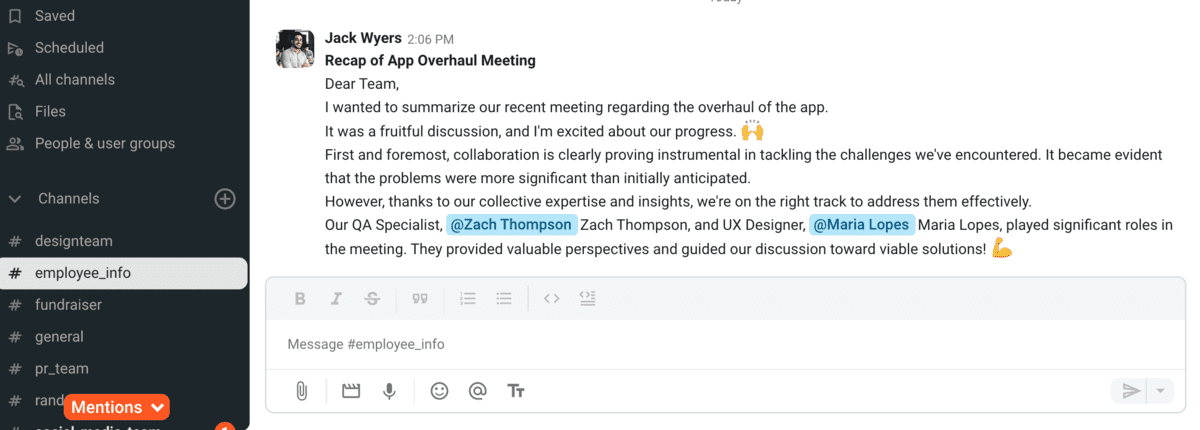
O Pumble simplifica a resolução de problemas
Se cada membro da equipe tivesse sido deixado por conta própria, resolver esta situação teria consumido muito tempo e esforço.
#2: A colaboração aumenta o compartilhamento de conhecimento e melhora o fluxo de informações
Organizações que desejam maximizar os benefícios da colaboração em equipe geralmente se concentram na gestão do conhecimento, e com razão.
Mesmo em uma startup ou pequena empresa, há vários especialistas que se destacam em diferentes áreas, é fundamental garantir que essa expertise seja compartilhada e disseminada por toda a empresa.
A colaboração é um gatilho necessário para o compartilhamento de conhecimento, pois:
- Reúne pessoas com habilidades divergentes,
- Abre linhas de comunicação entre colaboradores e
- Permite a transferência direta de conhecimento por meio do trabalho em grupo.
Os pontos mencionados são fundamentais para a colaboração interfuncional, que reúne profissionais de diferentes áreas para compartilhar insights e perspectivas que normalmente não teriam a oportunidade de explorar.
Este tipo de trabalho colaborativo também pode ajudar muito na eliminação de isolamento de informação, preparando melhor as organizações para enfrentar desafios futuros.
Exemplo de colaboração que aumenta o compartilhamento de conhecimento
Qualquer trabalho em grupo envolve um grau de compartilhamento de conhecimento, e isso se intensifica quando participamos de um projeto maior, como é o caso do exemplo a seguir.
Uma agência de design está trabalhando com um novo cliente, e as partes interessadas querem uma reformulação do site antigo e uma identidade visual completamente nova.
Como há muito que os designers podem fazer ao reformular um site, eles trabalham em conjunto com desenvolvedores web para garantir que cada elemento visual tenha uma aparência perfeita na web, aprendendo mais sobre seu trabalho a partir de uma perspectiva de programação.

Resolver problemas com elementos dinâmicos e interações de UI exige muito vai e vem. Como resultado da colaboração deles, o novo site tem uma aparência reconhecível com elementos coesos que atendem às necessidades do cliente.
🎓 Dica profissional do Pumble
Interessado em aprender mais sobre os benefícios de equipes multifuncionais e colaboração? Se sim, confira este guia detalhado:
#3: A colaboração fortalece os relacionamentos interpessoais
A colaboração fortalece os relacionamentos interpessoais O trabalho colaborativo aproxima os membros da equipe e os estimula a trabalhar juntos em um objetivo comum. Esse tipo de ambiente melhora os relacionamentos interpessoais entre os colaboradores, o que fortalece não apenas seus laços mútuos, mas também seu comprometimento com:
- Trabalho compartilhado,
- Equipe e
- Organização como um todo.
Consequentemente, os membros da equipe investem mais esforço em suas tarefas e sentem um grau maior de motivação.
Isso é particularmente importante para colegas que pertencem a departamentos diferentes e podem não ter muitas oportunidades de trabalhar juntos. O engajamento mútuo e a colaboração melhoram as conexões entre diferentes departamentos, criando um senso mais amplo de pertencimento que se estende além das equipes primárias dos colaboradores.
Exemplo de colaboração fortalecendo os relacionamentos interpessoais
Se você raramente tem a chance de trabalhar com diferentes departamentos, pode ser desafiador imaginar a comunicação com uma equipe com novos colegas de trabalho.
No entanto, como ilustrado no exemplo a seguir, essas situações podem levar a resultados excelentes.
Uma empresa de fintech decidiu participar de uma arrecadação de fundos para caridade, então uma equipe interdepartamental tem a tarefa de organizar um evento de arrecadação de fundos para toda a empresa.
A equipe terá que começar com a alocação de tarefas. Por exemplo, o especialista em mídia social vai espalhar a notícia sobre o evento em diferentes plataformas, enquanto o auxiliar de contabilidade cuidará do orçamento.
Inicialmente, as interações podem ocorrer apenas durante reuniões formais, mas com o tempo, eles podem se encontrar para intervalos de almoço ou bebidas depois do trabalho.
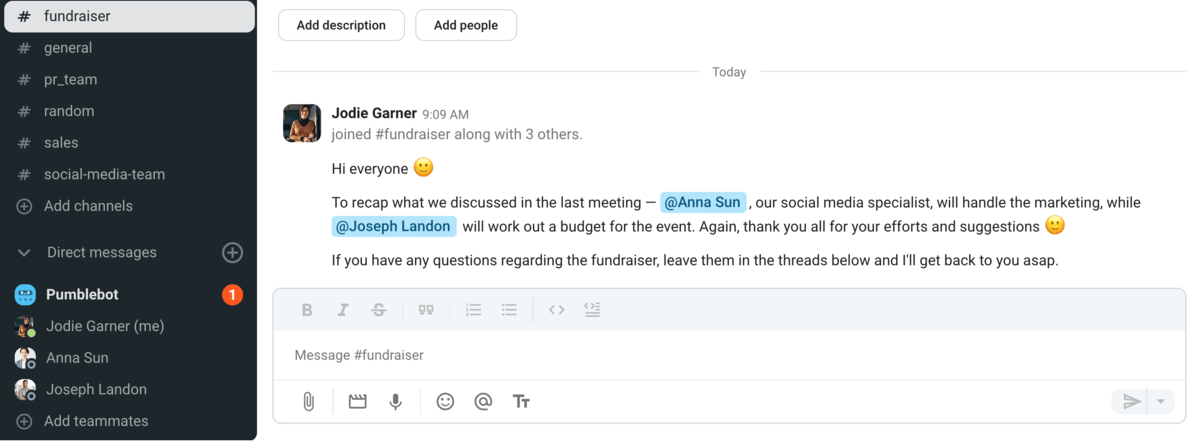
Aumente a conexão da sua equipe com o Pumble
Essas reuniões ajudarão os membros da equipe a se conectarem em um nível mais profundo, à medida que compartilham histórias pessoais ou anedotas do local de trabalho. E, à medida que essa conexão pessoal se aprofunda, também fortalecerá seus relacionamentos profissionais.
#4: A colaboração aumenta o alinhamento entre diferentes departamentos
Como mencionamos, quando sua equipe trabalha com um departamento diferente, a experiência pinta um quadro mais amplo de como a contribuição de cada pessoa leva a um objetivo maior.
Esse insight leva a uma melhor compreensão das diferentes funções da equipe dentro da estrutura mais ampla e ajuda a garantir que todos os departamentos permaneçam na mesma página e se concentrem em seus objetivos comuns.
Exemplo de colaboração aumentando o alinhamento entre diferentes departamentos
Se não nos conectarmos com equipes diferentes, provavelmente não vamos entender todos os lados de um projeto. Felizmente, não é isso que acontece em nosso exemplo.
Em uma empresa de desenvolvimento de software, a equipe de desenvolvimento de produtos estava criando um novo aplicativo que visa agilizar o gerenciamento de projetos para empresas. No entanto, a equipe de marketing viu uma deficiência entre os recursos que estão sendo desenvolvidos e as mensagens necessárias para promover efetivamente o software para futuros clientes.
No passado, tais contratempos teriam resultado em atrasos em lançamentos de produtos e esforços de marketing desarticulados. No entanto, desta vez, a empresa decidiu fomentar a colaboração com:
- Ciclos de feedback,
- Tomada de decisão conjunta e
- Reuniões multifuncionais.
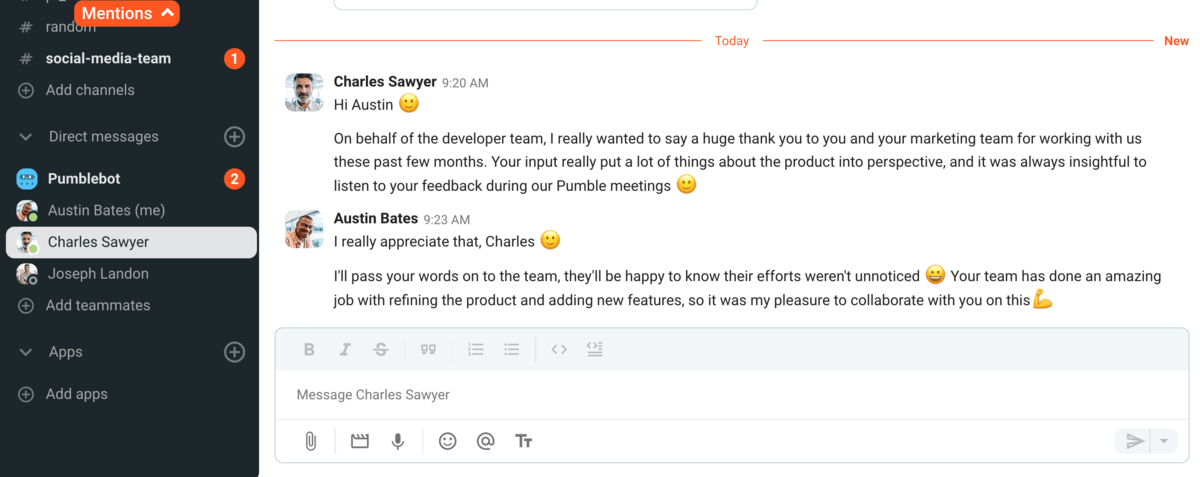
Graças a essas práticas, os resultados da colaboração multifuncional mantiveram as equipes alinhadas durante todas as fases do projeto.
#5: A colaboração reforça a cultura da empresa
A colaboração de qualidade promove uma cultura fundada em valores como:
- Transparência,
- Trabalho em equipe,
- Confiança e
- Suporte.
Criar uma comunidade dentro de uma organização começa com a identificação de valores essenciais, que incentivam o comprometimento com um objetivo comum. Quando todos usam esses valores, é muito mais fácil:
- Comunicar-se abertamente e
- Liderar com empatia.
Para colher os benefícios da colaboração no local de trabalho, sua equipe deve aplicar consistentemente os valores essenciais da empresa em suas interações diárias.
Além disso, a organização deve priorizar a segurança psicológica e a confiança para garantir que todos os funcionários se sintam fortalecidos e motivados.
Por exemplo, os empregadores podem demonstrar confiança:
- Oferecendo horários de trabalho flexíveis,
- Permitindo que as pessoas trabalhem remotamente e/ou
- Evitando microgerenciamento.
Uma vez que os funcionários se sintam psicologicamente seguros, eles estarão mais abertos a cometer erros e aprender novas habilidades sem temer repercussões negativas. Quando temos confiança e segurança psicológica, a experiência do funcionário dispara, o que aumenta o moraldos funcionários.
Exemplo de colaboração reforçando a cultura da empresa
Para ilustrar como a colaboração pode reforçar a cultura e a identidade de uma organização, veremos uma agência de design onde Carlos é o líder da equipe. Seu objetivo principal é promover o trabalho em equipe e dar suporte aos seus colegas.

Graças aos esforços de Charles e à política de trabalho flexível da agência, a equipe está constantemente compartilhando conhecimento e ideias, e esse espírito colaborativo se alinha com a identidade da empresa. Neste caso, Charles é um exemplo do que um bom gerente deve fazer por sua equipe — nutrir o sentimento de propósito compartilhado e pertencimento.
#6: A colaboração leva a maiores taxas de retenção
Um dos principais benefícios da colaboração para empresas é o aumento das taxas de retenção.
A colaboração infunde valor e significado nas tarefas diárias, destacando as conquistas da equipe em vez de sucessos individuais e promovendo laços mais fortes entre os colaboradores. Os funcionários se sentem valorizados e têm mais probabilidade de permanecerem na empresa.
Lembre-se de que a retenção é muito mais do que manter funcionários — trata-se de uma atmosfera que inspire as pessoas a darem o seu melhor enquanto trabalham juntas para atingir as metas organizacionais.
Para alcançar esse tipo de ambiente de trabalho positivo, os empregadores podem precisar:
- Adotar incentivos baseados em desempenho,
- Oferecer acordos de trabalho mais flexíveis e
- Fornecer pacotes de benefícios mais abrangentes.
Exemplo de colaboração que leva a maiores taxas de retenção
Startups são conhecidas por seu ritmo acelerado, mas quando adotam práticas de colaboração saudáveis, conseguem manter seus melhores talentos.
Jordan e seu esquadrão de startups de tecnologia — composto por Maureen, Charlie e Alistair — trabalham juntos há dois anos. Demorou um pouco para o grupo encontrar seu ritmo, mas uma vez que eles começaram a trocar ideias e a reunir suas experiências, nenhum desafio de codificação foi capaz de detê-los.
Jordan ouve ativamente sua equipe e elogia cada contribuição, aumentando o senso de conquista compartilhada e camaradagem. Como resultado, os membros da equipe valorizam as conexões que formaram e provavelmente permanecerão parte da startup por um longo tempo.

#7: A colaboração aumenta a produtividade
Quando substituímos a competição doentia pela colaboração, a produtividade floresce.
Para algumas pessoas, a pergunta "O que é colaboração?" evoca a imagem de um grupo de pessoas reunidas em uma mesa, trabalhando duro em um projeto importante. Na maioria das vezes, a colaboração é sobre pequenas interações, como pedir feedback ou orientação a um colega.
Com o surgimento de soluções para colaboração digital baseadas em nuvem, reunir informações de colegas que trabalham em diferentes departamentos é muito mais fácil. Então, a produtividade explode porque podemos lidar com tarefas administrativas rapidamente graças às ferramentas digitais. Por outro lado, a comunicação em tempo real continua sendo o meio para corrigir erros e encontrar novas abordagens ou soluções.
Exemplo de colaboração aumentando a produtividade
Quando o escopo de um projeto excede nossas capacidades, é fácil nos sentirmos sobrecarregados e vivenciar uma sobrecarga de trabalho.
Felizmente, não é isso que acontece com Lana em seu escritório de arquitetura. Ela conseguiu um novo projeto de reforma, e decidiu convocar Jackson, um designer de interiores, e Richard, um supervisor de construção, para ajudar a concluir tudo no prazo. Ela se sente um pouco apreensiva em trabalhar com contratados independentes, a colaboração entre eles demonstra que não há motivo para preocupações excessivas.
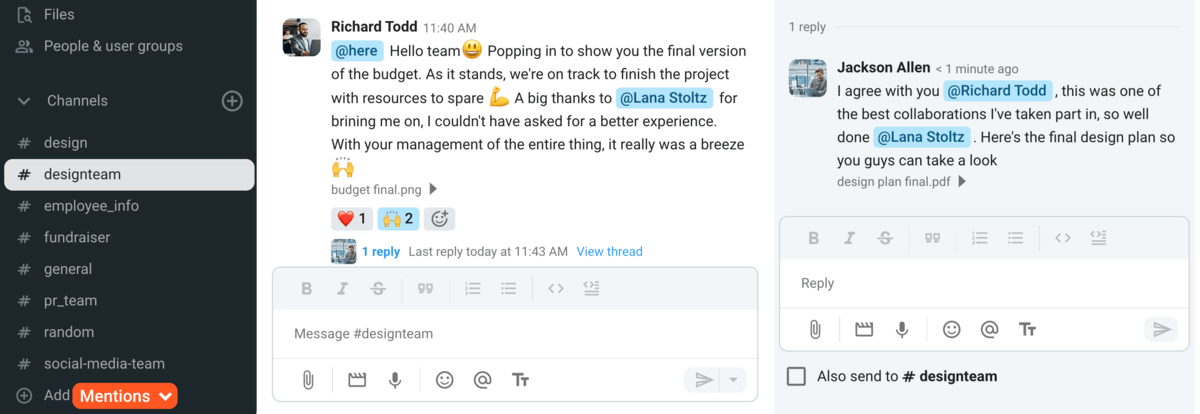
Os designs de Jackson exalam funcionalidade e criatividade, enquanto a expertise da gestão de Richard garante que a equipe não exceda seu orçamento. Junto com a alocação de tarefas de Lana, seus esforços otimizam a produtividade, e o resultado final satisfaz as necessidades do cliente.
#8: A colaboração expande nosso conjunto de habilidades
Todo trabalho colaborativo reúne uma ampla gama de talentos com diferentes pontos fortes, e o resultado de seus esforços geralmente é maior do que a soma de suas partes.
Essa experiência oferece uma perspectiva sobre diversos conjuntos de habilidades e conhecimentos, incentivando os colaboradores a aprender uns com os outros e a reavaliar suas próprias abordagens.
Toda colaboração é uma experiência de aprendizado — mesmo que não estejamos adotando novos conhecimentos e habilidades, a interação constante e o feedback construtivo nos permitem ajustar e melhorar nossa maneira de fazer as coisas.
Além disso, ambientes colaborativos são o ambiente perfeito para acelerar os processos de integração e transferência de conhecimento para novos membros da equipe.
Exemplo de colaboração expandindo nosso conjunto de habilidades
Quais são os benefícios da colaboração para estagiários e jovens profissionais? Vamos ver como foi para Emma, uma estagiária designada para auxiliar seus colegas mais experientes em um projeto.
Sua nova função envolveu trabalhar com Mina, uma desenvolvedora de software, e Tom, um designer de UX experiente, no desenvolvimento de um novo aplicativo.
A experiência de Tom e as habilidades técnicas de Mina se complementaram, enquanto Emma trouxe uma nova perspectiva e entusiasmo ao grupo.
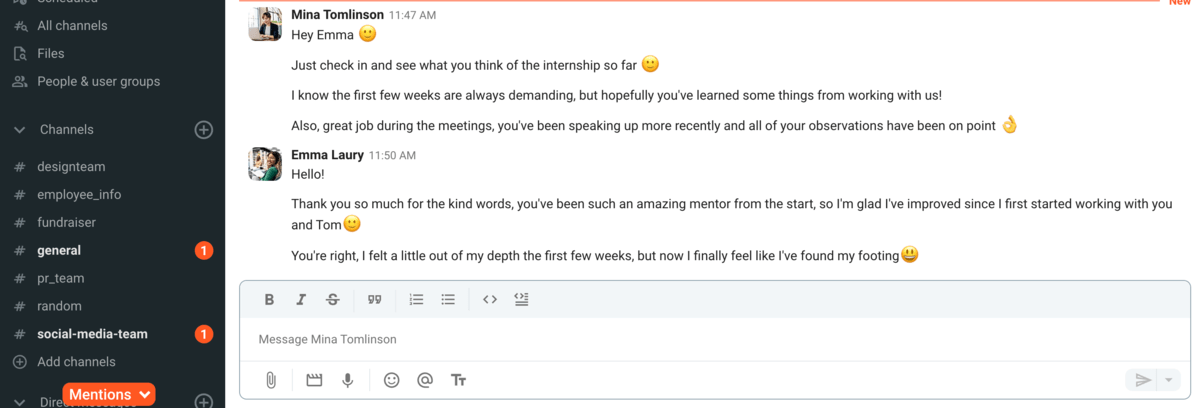
Mina foi mentora de Emma, enriquecendo suas habilidades de liderança e comunicação. Enquanto isso, Emma expressou livremente suas sugestões e aprendeu muito com seus colegas de trabalho mais experientes, tornando seu estágio ainda mais enriquecedor.
#9: A colaboração aumenta nossa compreensão de outras disciplinas
Colaborar com profissionais de diferentes áreas é uma excelente maneira de aprender de forma prática e direta.
Temos a oportunidade de observar sua abordagem e processo de pensamento, embora seu campo de especialização seja diferente do nosso. Essas experiências nos oferecem uma nova perspectiva, incitando-nos a entender como diferentes profissões e funções se encaixam no quadro geral da organização e seus objetivos. Além disso, aprimoramos nossas habilidades interpessoais e colaborativas sempre que entramos em contato com uma gama diversificada de:
- Metodologias
- Motivações e
- Pontos de vista.
Entender e abraçar essa diversidade é um dos benefícios cruciais da colaboração.
Exemplo de colaboração aumentando nossa compreensão de outras disciplinas
Quando você não tem uma visão completa do trabalho de seus colegas, é fácil subestimar suas contribuições. No entanto, sua opinião pode mudar quando você obtém uma visão privilegiada do que o trabalho deles envolve.
Jeremy, um designer de UX, se viu nessa situação e enviou uma mensagem para Doris, uma escritora técnica, para contar a ela como sua visão havia mudado.

Use o Pumble para melhorar a colaboração multifuncional
#10: A colaboração expande nossa rede profissional
O crescimento profissional e pessoal são algumas das vantagens mais valiosas da colaboração no local de trabalho. Mas, outro benefício da colaboração é a oportunidade de aumentar nossa rede profissional. Quanto mais pessoas entramos em contato com nossa área ou indústrias relacionadas, mais chances temos de encontrar novos:
- Mentores,
- Aliados,
- Parceiros de negócios e
- Colaboradores.
A credibilidade de suas conexões e a impressão que você deixa nos colaboradores podem fazer sua carreira avançar ainda mais.
Exemplo de colaboração expandindo nossa rede pessoal
Veja como Sarah, que foi recentemente promovida a uma posição de Gerente de Marketing em uma startup de tecnologia, aumentou sua rede profissional enquanto trabalhava no lançamento de um produto.
Durante a preparação para o lançamento, ela colaborou com:
- Mark, um designer gráfico,
- Lauren, uma redatora, e
- Donatan, um analista de dados.
Embora esta seja a primeira vez que todos trabalham juntos, eles conseguiram executar uma estratégia de marketing bem-sucedida.

Graças à experiência, Sarah ganhou contatos valiosos para futuras oportunidades de carreira e colaboração.
Colaboração da equipe Kickstart com Pumble
Sem comunicação de qualidade, não pode haver colaboração. Com o Pumble, você pode preparar sua equipe para o sucesso e estabelecer uma base sólida para aumentar a produtividade. Graças aos recursos amigáveis da plataforma, você pode manter as discussões estruturadas e focadas com:
Você não só pode usar os recursos de compartilhamento de tela e de arquivos com membros de suas equipes, mas também pode conceder acesso de convidado a colaboradores externos.

O Pumble está disponível em diferentes plataformas, facilitando a promoção de:
- Resolução de problemas,
- Aprendizado e
- Relacionamentos profissionais fortes.
Quer saber como o Pumble pode capacitar sua equipe? Dê aos seus colegas as ferramentas de que eles precisam!
Experimente o Pumble hoje mesmo
Como avaliamos esta publicação: Nossos escritores e editores monitoram as postagens e as atualizam quando novas informações ficam disponíveis, para mantê-las atualizadas e relevantes.


